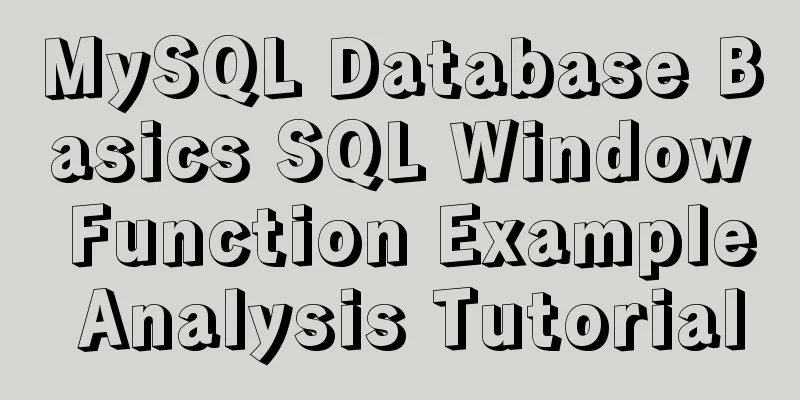Detailed process of building mysql5.7.29 on centos7 of linux

|
1. Download MySQL 1.1 Download address https://downloads.mysql.com/archives/community/ 1.2 Version selection
2. Manage group and directory permissions 2.1 Unzip mysql tar -zxf mysql-5.7.29-linux-glibc2.12-x86_64.tar.gz upload directory /home/tools
2.2 Rename mv mysql-5.7.29-linux-glibc2.12-x86_64 mysql-5.7.29
2.3 Move the specified directory mv mysql-5.7.29 /usr/local/
2.4 Add user groups and users groupadd mysql useradd -r -g mysql mysql
2.5 Modify directory permissions chown -R mysql:mysql /usr/local/mysql-5.7.29/ 3. Install MySQL 3.1 Configure MySQL service cp /usr/local/mysql-5.7.29/support-files/mysql.server /etc/init.d/mysql 3.2 Modify mysql service vi /etc/init.d/mysql
3.3 Modify the configuration file my.cnf vi /etc/my.cnf
The copied content is as follows, adjust the parameters as needed [client] port = 33066 default-character-set=utf8 [mysqld] # General configuration options basedir = /usr/local/mysql-5.7.29 datadir = /usr/local/mysql-5.7.29/data port = 33066 character-set-server=utf8 default_storage_engine = InnoDB sql_mode=STRICT_TRANS_TABLES,NO_ZERO_IN_DATE,NO_ZERO_DATE,ERROR_FOR_DIVISION_BY_ZEO, NO_AUTO_CREATE_USER,NO_ENGINE_SUBSTITUTION 3.4 Initialize MySQL /usr/local/mysql-5.7.29/bin/mysqld --initialize--user=mysql --basedir=/usr/local/mysql-5.7.29 --datadir=/usr/local/mysql-5.7.29/data Success is as follows, please note the password
3.5 Start the service service mysql start
4. Login and remote settings 4.1 Login to MySQL ./mysql -u root p Remember the registration password
4.2 Change the root login password set password=password('new password');
4.3 Enable remote access GRANT ALL PRIVILEGES ON *.* TO 'root'@'%' IDENTIFIED BY 'password'; flush privileges; 5. Environment variables and startup configuration 5.1 Setting environment variables vi /etc/profile Add the following content #mysql environment export MYSQL_HOME=/usr/local/mysql export PATH=$PATH:$MYSQL_HOME/bin source /etc/profile Update system variables 5.2 Startup chkconfig --add mysql mysql service to the automatic service chkconfig mysql on Set automatic startup chkconfig --list View the service list
Summarize This is the end of this article about the detailed process of building mysql5.7.29 on centos7 in linux. For more relevant content about building mysql5.7.29 on centos7, please search for previous articles on 123WORDPRESS.COM or continue to browse the following related articles. I hope you will support 123WORDPRESS.COM in the future! You may also be interested in:
|
<<: Teach you how to build hive3.1.2 on Tencent Cloud
>>: Example of Vue uploading files using formData format type
Recommend
Detailed explanation of MySQL redo log (redo log) and rollback log (undo logo)
Preface: The previous article described several c...
Vue integrates PDF.js to implement PDF preview and add watermark steps
Table of contents Achieve results Available plugi...
Share 20 excellent web form design cases
Sophie Hardach Clyde Quay Wharf 37 East Soapbox Rx...
Analysis of the Nesting Rules of XHTML Tags
In the XHTML language, we all know that the ul ta...
How to configure mysql on ubuntu server and implement remote connection
Server: Ubuntu Server 16.04 LSS Client: Ubuntu 16...
The architecture and practice of synchronizing Meituan DB data to the data warehouse
background In data warehouse modeling, the origin...
CentOS configures local yum source/Alibaba Cloud yum source/163yuan source and configures the priority of yum source
1. Use Centos image to build local yum source Sin...
Tutorial on installing MySQL 5.7.18 using RPM package
system: CentOS 7 RPM packages: mysql-community-cl...
Detailed steps to install docker in 5 minutes
Installing Docker on CentOS requires the operatin...
Summary of MySQL Architecture Knowledge Points
1. Databases and database instances In the study ...
Detailed explanation of nginx upstream configuration and function
Configuration Example upstream backend { server b...
Common usage of hook in react
Table of contents 1. What is a hook? 2. Why does ...
Vue+axios sample code for uploading pictures and recognizing faces
Table of contents Axios Request Qs processing dat...
The textarea tag cannot be resized and cannot be dragged with the mouse
The textarea tag size is immutable Copy code The c...
Brief analysis of the various versions of mysql.data.dll driver
Here is the mysql driver mysql.data.dll Notice: T...





















